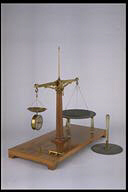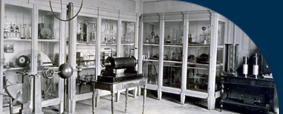
 |
Electrostatic balance |
 |
Bilancia elettrostatica |
| Subject: electrostatics/electrical forces, induction, polarization |
Settore: elettrostatica/forze elettriche, induzione, polarizzazione |
| Numbers of catalogue: 350, 207 |
Numeri di inventario: 350, 207 |
| Tecnomasio [document] |
Tecnomasio [documento] |
| 1870 [document] |
Periodo di costruzione: 1870 [documento] |
| Walnut, brass, cast-iron, glass, shellac, silver |
Materiali utilizzati: Noce, ottone , ghisa, vetro, gommalacca, argento |
300 X 618 x 595 [mm] |
Dimensioni: 300 X 618 X 595 [mm] |
| |
|
This type of electric balance is based upon the same principle of functioning of the first models of attraction electrometers, such as were used by Alessandro Volta ( ) and by William Snow Harris (1834). This balance was devised by the physicist Giovanni Cantoni (1818-1897) for his experiments on induction and on electrostatic polarization. With this balance Cantoni carried out and described numerous experiments showing the electrostatic forces and the permanent polarization of discs of insulating material that are one opposite the other, or in mutual contact, and placed between two conducting sheets charged with appropriate potentials. The presence of this device in the Urbino collection is almost certainly related to Serpieri's studies on electric potential, about which he published a brief dydactic treatise in 1882. |
Questo tipo di bilancia elettrica si fonda sul medesimo principio di funzionamento dei primi modelli di elettrometri ad attrazione quali quelli proposti da Alessandro Volta (???) e da William Snow Harris (1834). Essa fu ideata dal fisico Giovanni Cantoni (1818-1897) in relazione ai suoi studii sperimentali sull'induzione e la polarizzazione elettrostatica. Con tale bilancia Cantoni eseguì e descrisse numerose esperienze che evidenziavano le forze elettrostatiche e la polarizzazione permanente di dischi di materiale coibente affacciati a poca distanza l'uno dall'altro o in mutuo contatto ed interposti tra due lamine conduttrici caricate con opportune differenze di potenziale. La presenza di questo pezzo nella collezione urbinate è quasi certamente in relazione agli studi compiuti dal Serpieri sul potenziale elettrico di cui egli, nel 1882, pubblicò un breve trattato ad uso didattico. |
| |
|
Description: The balance has a base and a turned column of light walnut; the column supports a beam with equal arms made of brass, which has in the middle an upward index, a fulcrum with a steel base and a lever that sets the lifting mechanism in motion. The beam is engraved "Portata Kilog. 1" (Capacity: Kg 1). One of the two arms is linked, through three insulating strings, to a heavy cast-iron disc which is opposite another disc of the same metal. This disc has a larger diameter and is supported by three glass feet (insulated with shellac) which are placed on the wooden base. A small pierced brass peg, which is under the larger disc, enables connection with an electrostatic generator and to charge the disc to the desired potential. The other arm is linked, through three insulating strings, to a small brass pan on the underside of which is welded a hook. The hook is linked to a dynamometer having a thin plane spiral the thread of mechanical tension of which is connected with the extremity of an endless screw placed horizontally under the dynamometer. By rotating the screw, one gradually changes the tension of the thread that controls the lowering of the brass pan on which sample weights can be placed to balance the device. The dynamometer also has a pointer and a circular silvered scale calibrated in grams (0-200). |
Descrizione: la bilancia ha un basamento e una colonna tornita in noce chiaro; la colonna sostiene il giogo a bracci uguali, interamente d'ottone, avente centralmente un indice riportato verso l'alto, un coltello con piano d'appoggio in acciaio e una leva che aziona il meccanismo di sollevamento del giogo stesso. Questo porta inciso lateralmente la scritta "PORTATA KILOG. 1." Un braccio reca sospeso, tramite tre corde isolanti, un pesante disco di ghisa affacciato ad un altro disco dello stesso metallo, di diametro maggiore, sostenuto da tre piedi in vetro (ben isolati con della gommalacca) che poggiano sul basamento ligneo. Un piccolo piolo forato d'ottone, posizionato sotto il disco maggiore, permette di connetterlo ad un generatore elettrostatico e di portarlo al potenziale voluto. L'altro braccio reca sospeso, tramite tre corde isolanti, un piattello d'ottone, sulla cui faccia inferiore è saldato un gancetto. Ad esso è collegato un dinamometro a sottile elica piana il cui filo di tensione meccanica è collegato all'estremo di una vite perpetua posta orizzontalmente sotto il dinamometro. Ruotando la vite, si varia gradualmente la tensione del filo che regola l'abbassamento del piattello d'ottone su cui si possono anche adagiare, per l'equilibrio della bilancia, dei pesi campione. Il dinamometro è fornito di un indice e di una scala circolare argentata tarata in grammi-peso (0-200). |
| |
|
Function: A simple experiment consists of measuring the force of electrostatic attraction between two metal discs that are opposite each other and that are held in balance (with a zero charge) at a short distance from one another, by means of small weights and of special manual adjustments to the calibration of the dynamometer (which will indicate zero in these situations). By charging the two metal discs with a generator of continuous tension, they will attract one another: the force of attraction will be indicated by the dynamometer. |
Funzionamento: una semplice esperienza consiste nel misurare la forza di attrazione elettrostatica tra due dischi metallici affacciati l'uno di fronte all'altro e tenuti in equilibrio (in condizioni di carica zero) a piccola distanza reciproca, da pesetti e da opportune regolazioni manuali di taratura del dinamometro (che in queste condizioni indicherà quindi il valore zero). Caricando con un generatore di tensione continua i due dischi metallici, essi si attrarranno: la forza di attrazione sarà indicata dal dinamometro
|
| |
|
Bibliography: Cantoni [1873], pp. 7-64; Cantoni [1885], part II, pp. 257-259. |
Bibliografia: Cantoni [1873], pp. 7-64; Cantoni [1885], parte II, pp. 257-259. |
|
|

